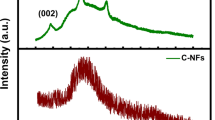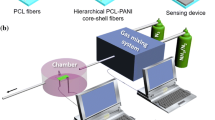Abstract
Chemiresistive ammonia (NH3) detection at room temperature is highly desired due to the unique merits of easy miniaturization, low cost, and minor energy consumption especially for portable and wearable electronics. In this regard, poly(3,4-ethylenedioxythiophene):polystyrenesulfonate (PEDOT:PSS) has sparked considerable attention due to the benign room-temperature conductivity and environmental stability, but it is undesirably impeded by limited sensitivity and sluggish reaction kinetics. To overcome these, we incorporated cellulose nanofibers (CNF) into PEDOT:PSS via a facile blending. The constituent-optimized composite sensor displayed sensitive (sensitivity of ∼7.46%/ppm in the range of 0.2–3 ppm), selective, and stable NH3 sensing at 25 °C at 55% RH, with higher response and less baseline drift than pure PEDOT:PSS counterparts. Additionally, the response/recovery times (4.9 s/5.2 s toward 1 ppm NH3) ranked the best cases of conducting polymers based NH3 sensors. The humidity involved more than twofold response enhancement indicated a huge potential in exhaled breath monitoring. Furthermore, we observed an excellent flexible NH3-sensing performance with bending-tolerant features. This work provides an alternative strategy for trace NH3 sensing with low power consumption, superfast reaction, and high sensitivity.
Graphical abstract









Similar content being viewed by others
References
Li XG, Li XX, Li Z, Wang J, Zhang JW (2017) WS2 nanoflakes based selective ammonia sensors at room temperature. Sensors Actuators B Chem 240:273–277
US Department of Health and Human Services (1992) Occupational safety and health guideline for ammonia. US Department of Health and Human Services, Washington, DC
Ho KF, Lee SC, Chan CK, Yu JC, Chow JC, Yao XH (2003) Characterization of chemical species in PM2.5 and PM10 aerosols in Hong Kong. Atmos Environ 37:31–39
Wu ZQ, Chen XD, Zhu SB, Zhou ZW, Yao Y, Quan W, Liu B (2013) Enhanced sensitivity of ammonia sensor using graphene/polyaniline nanocomposite. Sensors Actuators B Chem 178:485–493
Gao LF, Yang X, Shu Y, Chen XW, Wang JH (2018) Ionic liquid-based slab optical waveguide sensor for the detection of ammonia in human breath. J Colloid Interface Sci 512:819–825
Davies S, Spanel P, Smith D (1997) Quantitative analysis of ammonia on the breath of patients in end-stage renal failure. Kidney Int 52:223–228
Hu NT, Yang Z, Wang YY, Zhang LL, Wang Y, Huang XL, Wei H, Wei LM, Zhang YF (2014) Ultrafast and sensitive room temperature NH3 gas sensors based on chemically reduced graphene oxide. Nanotechnology 25:025502
Zhou Y, Wang YH, Wang YJ, Yu HC, Zhang RJ, Li J, Zang ZG, Li X (2021) MXene Ti3C2Tx-derived nitrogen-functionalized heterophase TiO2 homojunctions for room-temperature trace ammonia gas sensing. ACS Appl Mater Interfaces 13:56485–56497
Wang YJ, Zhou Y, Wang YH, Zhang RJ, Li J, Li X, Zang ZG (2021) Conductometric room temperature ammonia sensors based on titanium dioxide nanoparticles decorated thin black phosphorus nanosheets. Sensors Actuators B Chem 349:130770
Khan H, Malook K, Shah M (2017) Highly selective and sensitive ammonia sensor using polypyrrole/V2O5 composites. J Mater Sci: Mater Electron 28:13873–13879
Choi J, Lee J, Choi J, Jung D, Shim SE (2010) Electrospun PEDOT:PSS/PVP nanofibers as the chemiresistor in chemical vapour sensing. Synth Met 160:1415–1421
Pang ZY, Nie QX, Zhu YN, Ge MQ, Chen MQ (2019) Enhanced ammonia sensing characteristics of CeO2-decorated SiO2/PANI free-standing nanofibrous membranes. J Mater Sci 54:2333–2342
De France KJ, Hoare T, Cranston ED (2017) Review of hydrogels and aerogels containing nanocellulose. Chem Mater 29:4609–4631
Ummartyotin S, Manuspiya H (2015) A critical review on cellulose: from fundamental to an approach on sensor technology. Renew Sustain Energy Rev 41:402–412
Yun S, Kim J (2010) Multi-walled carbon nanotubes-cellulose paper for a chemical vapor sensor. Sensors Actuators B Chem 150:308–313
Ivanova A, Frka-Petesic B, Paul A, Wagner T, Jumabekov AN, Vilk Y, Weber J, Gunne J, Vignolini S, Tiemann M, Fattakhova-Rohlfing D, Bein T (2020) Cellulose nanocrystal-templated tin dioxide thin films for gas sensing. ACS Appl Mater Interfaces 12:12639–12647
Tong X, Zhang XJ, Li J, Wang H (2021) Flexible NH3 gas sensor based on TiO2/cellulose nanocrystals composite film at room temperature. J Mater Sci: Mater Electron 32:23566–23577
Qiu JY, Xia XL, Hu ZH, Zhou S, Wang YJ, Wang YH, Zhang RJ, Li J, Zhou Y (2022) Molecular ammonia sensing of PEDOT:PSS/nitrogen doped MXene Ti3C2Tx composite film at room temperature. Nanotechnology 33:065501
Lay M, Pelach MA, Pellicer N, Tarres JA, Bun KN, Vilaseca F (2017) Smart nanopaper based on cellulose nanofibers with hybrid PEDOT:PSS/polypyrrole for energy storage devices. Carbohydr Polym 165:86–95
Li MC, Wu Q, Song K, Lee S, Qing Y, Wu Y (2015) Cellulose nanoparticles: structure-morphology-rheology relationships. ACS Sustain Chem Eng 3:821–832
Du H, Zhang M, Liu K, Parit M, Jiang Z, Zhang X, Li B, Si C (2022) Conductive PEDOT:PSS/cellulose nanofibril paper electrodes for flexible supercapacitors with superior areal capacitance and cycling stability. Chem Eng J 428:131994
Li Y, Ban HT, Yang MJ (2016) Highly sensitive NH3 gas sensors based on novel polypyrrole-coated SnO2 nanosheet nanocomposites. Sensors Actuators B Chem 224:449–457
Tian JF, Yang G, Jiang DG, Su FF, Zhang ZH (2016) A hybrid material consisting of bulk-reduced TiO2, graphene oxide and polyaniline for resistance based sensing of gaseous ammonia at room temperature. Microchim Acta 183:2871–2878
Kumar V, Patil V, Apte A, Harale N, Patil P, Kulkarni S (2015) Ultrasensitive gold nanostar-polyaniline composite for ammonia gas sensing. Langmuir 31:13247–13256
Singh P, Kushwaha CS, Singh VK, Dubey GC, Shukla SK (2021) Chemiresistive sensing of volatile ammonia over zinc oxide encapsulated polypyrrole based nanocomposite. Sensors Actuators B Chem 342:130042
Luo GF, Xie LL, He M, Jaisutti R, Zhu ZG (2021) Flexible fabric gas sensors based on reduced graphene-polyaniline nanocomposite for highly sensitive NH3 detection at room temperature. Nanotechnology 32:305501
Li ZY, Chen JY, Chen L, Guo ML, Wu YP, Wei Y, Wang JF, Wang XG (2020) Hollow Au/polypyrrole capsules to form porous and neural network-like nanofibrous film for wearable, super-rapid, and ultrasensitive NH3 sensor at room temperature. ACS Appl Mater Interfaces 12:55056–55063
Li SY, Chen SJ, Zhuo BG, Li QF, Liu WJ, Guo XJ (2017) Flexible ammonia sensor based on PEDOT:PSS/silver nanowire composite film for meat freshness monitoring. IEEE Electron Device Lett 38:975–978
Wang S, Jiang YD, Liu BH, Duan ZH, Pan H, Yuan Z, Xie GZ, Wang JB, Fang Z, Tai HL (2021) Ultrathin Nb2CTx nanosheets-supported polyaniline nanocomposite: enabling ultrasensitive NH3 detection. Sensors Actuators B Chem 343:130069
Yang LY, Yang L, Wu SN, Wei F, Hu Y, Xu XR, Zhang L, Sun DP (2020) Three-dimensional conductive organic sulfonic acid co-doped bacterial cellulose/polyaniline nanocomposite films for detection of ammonia at room temperature. Sensors Actuators B Chem 323:128689
Tang N, Jiang Y, Qu HM, Duan XX (2017) Conductive polymer nanowire gas sensor fabricated by nanoscale soft lithography. Nanotechnology 28:485301
Pacher P, Lex A, Eder S, Trimmel G, Slugovc C, List EJW, Zojer E (2010) A novel concept for humidity compensated sub-ppm ammonia detection. Sensors Actuators B Chem 145:181–184
Dan YP, Cao YY, Mallouk TE, Johnson AT, Evoy S (2007) Dielectrophoretically assembled polymer nanowires for gas sensing. Sensors Actuators B Chem 125:55–59
Funding
This work was partially supported by Fundamental and Frontier Research Project of Chongqing (Grant No. cstc2019jcyj-msxmX0037), and National Natural Science Foundation of China (Grant No. 61704014).
Author information
Authors and Affiliations
Contributions
RZ: formal analysis, conceptualization, investigation, validation, writing—original draft.
YW, JL, HZ, YW: formal analysis, investigation, validation.
YZ: supervision, methodology, writing—review and editing, project administration, funding acquisition, methodology.
Corresponding author
Ethics declarations
Conflict of interest
The authors declare no competing interests.
Additional information
Publisher's note
Springer Nature remains neutral with regard to jurisdictional claims in published maps and institutional affiliations.
Supplementary Information
Below is the link to the electronic supplementary material.
Rights and permissions
Springer Nature or its licensor holds exclusive rights to this article under a publishing agreement with the author(s) or other rightsholder(s); author self-archiving of the accepted manuscript version of this article is solely governed by the terms of such publishing agreement and applicable law.
About this article
Cite this article
Zhang, R., Wang, Y., Li, J. et al. Mesoporous cellulose nanofibers-interlaced PEDOT:PSS hybrids for chemiresistive ammonia detection. Microchim Acta 189, 308 (2022). https://doi.org/10.1007/s00604-022-05414-2
Received:
Accepted:
Published:
DOI: https://doi.org/10.1007/s00604-022-05414-2




